Diplomatic Bluebook 2015
Chapter 3
Japan’s Foreign Policy to Promote National and Worldwide Interests
1.Efforts Contributing to the Revitalization of the Japanese Economy
(1) Promotion of Economic Partnerships
EPAs and FTAs have effects on incorporating the vitality of high growth markets overseas and strengthening the foundation of the Japanese economy, by reduction or elimination of tariffs on goods and of trade barriers for services, rule-making on trade and investment and other measures. The government of Japan has concluded EPAs or FTAs with 14 countries and regions. In order to achieve the goal set out in “Japan Revitalization Strategy” to increase the FTA ratio in Japan’s trade (the ratio of trade with countries which already signed or existing FTAs with Japan to the total trade value) to 70% from about 19% in 2012 by 2018, Japan is strategically promoting economic partnerships with countries in the Asia-Pacific region and Europe.
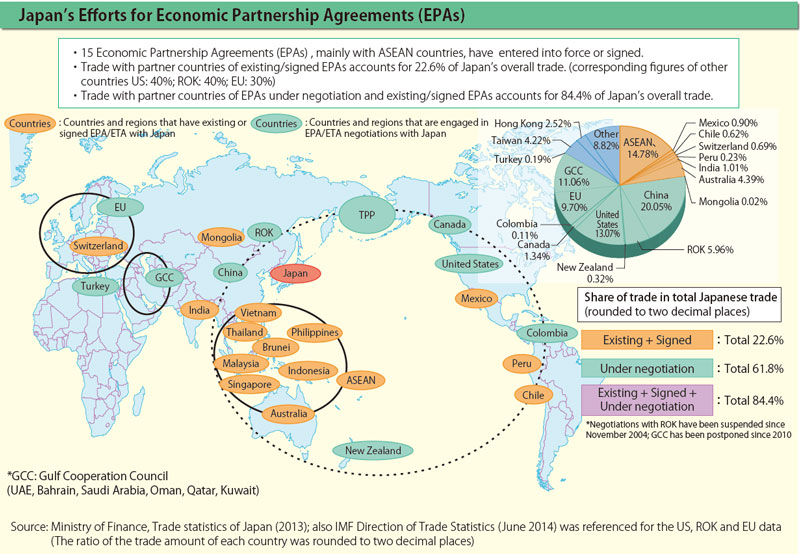
After seven years of negotiations, the Japan-Australia Economic Partnership Agreement (EPA) was signed in 2014 and entered into force in January 2015. It increased the FTA ratio from about 19% in 2012 to about 23%. Japan steadily continues developing economic partnerships. For example, Japan confirmed an agreement in principle of Japan-Mongolia EPA in July 2014 and signed it in February 2015, and negotiation of Japan-Turkey EPA has started in December. As one of the pillars in the Growth Strategy, Japan will continuously foster economic partnerships.
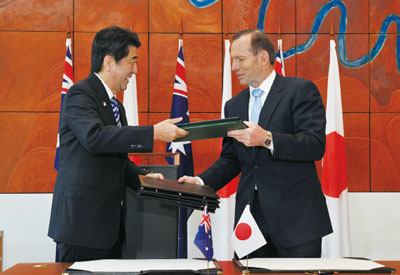 Signing ceremony by Japanese and Australian leaders (July 8, Australia; Source: Cabinet Public Relations Office)
Signing ceremony by Japanese and Australian leaders (July 8, Australia; Source: Cabinet Public Relations Office)
A. EPA which entered into force after 2014 (Australia)
Japan and Australia are strategic partners collaborating closely in the Asia-Pacific Region and in the international society. They share close relationship not only in the area of the economy as major trading partner of energy and food, but also in the areas of politics and security. The two countries decided to launch bilateral EPA negotiations at the Japan-Australia Summit Telephone Talk in 2006, and held sixteen rounds of negotiations by 2012. As a result, the agreement was signed by the leaders of both countries on the occasion of Prime Minister Shinzo Abe’s visit to Australia in July 2014, and entered into force in January 2015.
B. Agreements currently under negotiation (Arranged in chronological order according to the time at which they start. For FTAAP-related issues, see C.)
(a) Republic of Korea (ROK)
Japan and the neighboring country, the ROK, have a mutually dependent and strong relationship in the economy including trade and investment. Based on the concept that the EPA with the ROK will provide both countries with a stable economic framework and bring about mutual benefits for the future, the two countries launched negotiations in 2003. Though the negotiations have been suspended since 2004, both countries have continued working level discussion.
(b) Gulf Cooperation Council (GCC)
GCC1 member states are extremely important as oil and natural gas suppliers to Japan. Though the FTA negotiation launched in 2006, it has been suspended for certain reasons of the GCC side. Japan has called for an early resumption of the negotiation with the aim to further strengthen economic relations with the GCC.
- 1 GCC stands for Gulf Cooperation Council; consisting of six countries including Bahrain, Kuwait, Oman, Qatar, Saudi Arabia, and United Arab Emirates.
(c) Mongolia
Japan launched EPA negotiations in 2012 with Mongolia, where mid-and-long-term high economic growth is expected, aiming at the improvement of the investment environment including energy and mineral resource sectors, as well as the further expansion of the trade and investment. After seven rounds of negotiations, the two countries reached an agreement in principle at the Japan-Mongolia Summit Meeting, when H.E. Mr. Tsakhia Elbegdorj, the President of Mongolia visited Japan in July 2014.
(d) Canada
Japan launched negotiations with Canada in 2012, which shares fundamental values and has a mutually dependent economic relationship with Japan. By December 2014, seven rounds of negotiation meetings were held, so that the EPA will contribute to a stable supply of energy, minerals, and food to Japan.
(e) Colombia
Colombia, which has rich resources and maintains a high economic growth rate, has concluded FTAs with various countries. From the viewpoint of improving the investment environment for Japanese companies, Japan started EPA negotiations in 2012, and by December 2014, nine rounds of negotiations were held.
(f) European Union (EU)
Japan decided to launch negotiations in March 2013 with the EU, which shares fundamental values with Japan and is a major trade and investment partner of Japan. Since the first round of negotiations was held in April 2013, eight rounds of negotiations has been held until December 2014. At the Japan-EU Summit Meeting, which was held on the occasion of the G20 Brisbane Summit in November 2014, Japan and the EU shared the view to accelerate negotiations, aiming to reach agreement in principle during 2015.
(g) Turkey
With Turkey, which has high economic potential and promotes an open economy, Japan agreed to launch EPA negotiations in January 2014 at a bilateral Summit Meeting between Recep Tayyip Erdogan, Prime Minister of the Republic of Turkey, and Prime Minister Abe during Prime Minister Erdogan’s visit to Japan. In December 2014, the first round of negotiations was held.
C. Pathways to the Free Trade Area of the Asia-Pacific (FTAAP)
(a) Trans-Pacific Partnership (TPP)
The TPP Agreement is an ambitious effort to establish new and 21st century rules for economic integration with countries sharing universal values in the fast-growing Asia-Pacific Region. While this Agreement not only covers trade in goods but also will create new rules in a wide range of areas including services, investment, intellectual property, financial services, electronic commerce, and disciplines on state-owned enterprises, it can also create a large value chain. As of December 2014, the negotiation is held by 12 countries, namely Japan, Singapore, New Zealand, Chile, Brunei, the United States, Australia, Peru, Viet Nam, Malaysia, Mexico, and Canada.
Japan officially joined in the negotiations in July 2013. By December 2014, Japan negotiated with other countries vigorously through various meetings including seven Ministerial meetings and two Leaders meetings. The TPP has the potential to incorporate the Asia-Pacific region’s growth into Japan and it is one of the major pillars in Japan’s Growth Strategy. Japan will make efforts together with other countries for an early conclusion of the negotiation and will continue to make utmost efforts in the negotiation, so that its national interests will be reflected firmly in the final result.
(b) Japan-China-ROK FTA
With regard to the Japan-China-ROK FTA, negotiation was launched in March 2013, and six rounds of negotiations were held by January 2015. Three countries have held the negotiations over a wide range of fields including trade in goods, investment, trade in services, competition, intellectual property, and electronic commerce, with the shared objective to pursue a comprehensive and high-level FTA.
(c) Regional Comprehensive Economic Partnership (RCEP)
RCEP negotiation aims at realizing the establishment of a broad economic integration, which covers a population of about 3.4 billion US dollars (approximately half of the world population), GDP of about 20 trillion US dollars (approximately 30% of the world GDP), and a total trade amount of about 10 trillion US dollars (approximately 30% of the world total trade amount). Since the launch of negotiations in May 2013, the leaders of ASEAN member states and their FTA partners states (six countries including Japan, China, the ROK, Australia, New Zealand, and India), have been working together to accomplish a comprehensive and high-level agreement in areas such as trade in goods, trade in services, investment, competition, and intellectual property, among others. By December 2014, two Ministerial meetings and six rounds of negotiations were held.


D. Existing agreements
The existing EPAs contain provisions concerning the Joint Committee, which is a body to discuss implementation of the Agreements, and a process to review the agreements after certain period of time elapses since the entry into force of each Agreement. In addition, a variety of consultations are held in order to utilize the existing EPAs effectively.
E. Movement of natural persons
In accordance with the EPAs, Japan has started to accept nurses and care worker candidates from Indonesia, the Philippines and Vietnam. In 2014, Japan permitted the entry of 187 Indonesians (41 nurses and 146 care workers), 183 Filipinos (36 nurses and 147 care workers), and 138 Vietnamese (21 nurses and 117 care workers). In 2014, 32 nurses (16 Indonesians and 16 Filipinos) and 78 care workers (46 Indonesians and 32 Filipinos) passed the national examination2 in 2014. As for nurses and care worker candidates from Vietnam, Japan accepted the first group in June 2014.
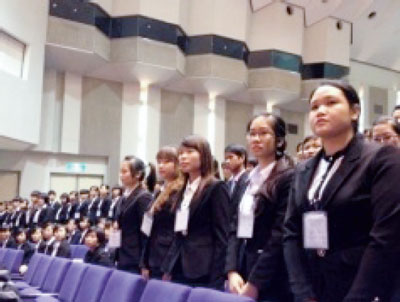 The first group of Vietnamese nurse and care worker candidates attends the opening ceremony for the Japanese language course in Japan (August 14, MOFA website)
The first group of Vietnamese nurse and care worker candidates attends the opening ceremony for the Japanese language course in Japan (August 14, MOFA website)
- 2 The number of Vietnamese passing the national examination will be released in March 2015.
(2) Support for Japanese companies
A. Promotion of Japanese companies’ overseas business expansion by Ministry of Foreign Affairs (MOFA) and accompanying diplomatic missions overseas
Under the leadership of “Headquarters for the Promotion of Japanese Business Support” headed by the Foreign Minister, MOFA has engaged in tandem with the diplomatic missions overseas in supporting Japanese companies in order to promote overseas business expansion.
In February, in order to further strengthen the supporting system for small and medium-sized enterprises’ (SMEs) overseas business expansion, MOFA commenced operations of “SMEs’ Overseas Development Fastpass3” together with the Ministry of Economy, Trade and Industry. In the Japan Revitalization Strategy, “Strategy of Global Outreach” is addressed as one of the action plans. Against a backdrop of this situation, the “Guidelines to support the overseas activities of Japanese companies,” which serve as guidelines for the diplomatic missions overseas in supporting Japanese companies, were amended in July so as to obtain shares in the global growing markets and incorporate them into the growth of the Japanese economy through joint efforts of the public and private sectors.
 Exhibition of Japanese hybrid cars at the Japanese Embassy in Switzerland
Exhibition of Japanese hybrid cars at the Japanese Embassy in Switzerland
Contact points for Japanese companies have been established at the diplomatic missions overseas (287 personnel at 215 diplomatic missions overseas in 140 countries as of December 2014) since 1999 and actively respond to inquiries from Japanese companies asking for consultation or support. Furthermore, the diplomatic missions overseas take the lead to provide services such as information supply to Japanese companies and campaign to local governments and organizations. On top of that, making use of events at the diplomatic missions overseas, such as a reception for the birthday of the Emperor of Japan, MOFA exhibits products and technology of Japanese companies through cooperation between the public and private sectors and holds PR seminars for Japanese companies’ products as well as exchanging meetings with local companies co-sponsored by Japanese companies. MOFA compiled such efforts into a booklet of “Good practices.”
- 3 The scheme to facilitate the introduction of companies from corporation support organizations such as regional financial institutions or chambers of commerce to organizations to support overseas business expansion, such as MOFA (including the diplomatic missions overseas) and JETRO.
B. Promotion of overseas business expansion of the Japanese infrastructure system
In order to respond to infrastructure demands mainly in emerging countries, and promote the infrastructure exports by Japanese companies, a “Ministerial Meeting on Strategy for Infrastructure Export and Economic Cooperation” consisting of cabinet ministers concerned was established within the government in 2013. Since then, a total of 14 meetings by category have been held in accordance with diplomatic schedule (as of December 2014), for example, meetings focused on countries or regions such as, “Myanmar,” “the Middle East and North Africa,” “India,” and “Latin America and the Caribbean” or on specific themes such as “urban infrastructure exports by advanced local government” and “disaster risk reduction.” Accordingly, through the schemes including the promotion of “top-level sales” led by officials including Prime Minister Abe and Foreign Minister Fumio Kishida, the reopening of JICA’s overseas investment and loans, and the improved system to make use of yen credits more strategically, the framework to promote the development of overseas business expansion of the Japanese infrastructure system is maintained and reinforced. MOFA has appointed 128 “Specialists in Infrastructure Projects,” who gather and consolidate information regarding infrastructure projects, in the diplomatic missions overseas in countries of focus (at 63 diplomatic missions overseas in 51 countries as of December 2014).
As concrete results of these efforts, Japanese companies or their group companies received orders for such projects as an international airport (Mongolia), a dedicated freight train railroad (India), a metropolitan railway (Indonesia), railway vehicles (the United Kingdom and the United States), maintenance of sewage lines (Malaysia), a chemical plant (Turkmenistan), urban railway vehicles, and a package of signals, electrical transformation and communication facilities (Thailand). The number of infrastructure orders received in 2013 significantly increased, at least from about 3.2 trillion yen in the previous year to about 9.3 trillion yen.
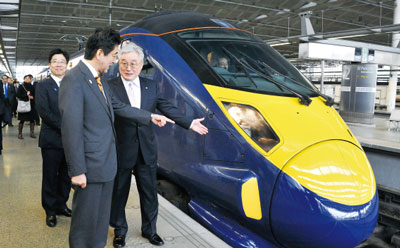 High-Speed Railway in the United Kingdom (May 2, London; Source: Cabinet Public Relations Office)
High-Speed Railway in the United Kingdom (May 2, London; Source: Cabinet Public Relations Office)
C. Investment treaty/tax treaty/agreement (between) on social security
(a) Investment treaty
In order to promote the investment environment overseas and attract foreign investment to the Japanese market, Japan has actively engaged in the conclusion of investment treaties. In 2014, investment treaties with Papua New Guinea, Kuwait, China, the ROK (Japan-China-ROK trilateral investment treaty), Iraq, Myanmar, and Mozambique took effect respectively. With regard to an investment treaty with Columbia, Japan has already completed its domestic procedures, and an investment treaty was signed also with Kazakhstan. Furthermore, an investment treaty was signed between Japan and Uruguay in 2015, which brought the total number of signed or concluded investment treaties to 25. Other than this, it is also noteworthy that Japan reached a substantial agreement with Ukraine. Currently, investment treaty negotiations with Oman, Angola, Algeria, Qatar, United Arab Emirates, Kenya, Ghana, Morocco, and Tanzania are in progress. Additionally, Japan has worked on the conclusion of EPAs including rules concerning investment. 11 out of 14 EPAs, including the Japan-Australia EPA, which entered into force in January 2015, contain rules concerning investment. In addition, Japan is conducting discussion about investments in the ongoing negotiations of agreements as follows, the TPP Agreement, Japan-China-ROK FTA, RCEP, and AJCEP, or EPAs with the EU, Canada, Mongolia, and Turkey.
Further, within the international frameworks such as the OECD and APEC, Japan has promoted the creation of multilateral rules for liberalization and facilitation of investment vigorously.
(b) Tax treaties
Tax treaties provide an important legal basis not only to avoid international dual taxation against cross-border economic activities, but also to lower the withholding tax rates in the source-country on investment income (dividend, interest, and fees) or eliminate completely such tax, and thus promote investment exchanges. It is also important from the viewpoint that they stipulate provisions to promote international cooperation between tax authorities through such measures as information exchange, which is likewise important in preventing international tax evasion or tax avoidance. Japan is actively making effort in promoting the expansion of tax treaty networks. In concrete terms, the agreements with Oman (in September) and the United Arab Emirates (in December), the Amending Protocols with Sweden (in October) and the United Kingdom (in December) were enacted, and a substantial agreement with Qatar (in December) was essentially concluded. Agreements mainly designed to develop and expand networks for exchanging information relating to tax matters were also enacted with Macao (in May) as well as the British Virgin Islands (in October). As a result, Japan had concluded a total number of 64 tax-related treaties (applicable to 89 countries and regions) as of the end of 2014.
(c) Agreement on social security
The purpose of agreements on social security is to resolve the issues of double payment and no refund of social security insurance premiums. It is expected to unload the burden of Japanese companies and Japanese citizens working or residing overseas, facilitate people-to-people exchange, and thus further bilateral relations. Japan signed an agreement with Luxembourg in October, which brought the total number of countries which concluded or signed such agreements on social security to 18. Furthermore, in 2014, Japan and Turkey conducted negotiations between the two governments.
D. Intellectual property
Strengthening the protection of intellectual property is extremely important for the promotion of technological innovation, and eventually for the development of the economy. Japan has actively participated in multilateral consultations, such as APEC, the WTO (TRIPS Council4), and the World Intellectual Property Organization (WIPO). In June 2014, Japan concluded the Beijing Treaty on Audiovisual Performances of the WIPO. With regard to the EPAs, Japan has aimed to include provisions concerning intellectual property to the greatest extent possible5. In addition, Japan has engaged in activities leading to the enforcement of the Anti-Counterfeiting Trade Agreement (ACTA). Also, in order to contribute to strengthening the protection of intellectual property and enhancing the abilities of government officials in developing countries in such fields as countermeasures against counterfeited or pirated goods, Japan has dispatched experts to those countries through JICA.
Moreover, MOFA has been taking measures to reinforce the protection of intellectual property rights overseas, and countermeasures against counterfeited or pirated goods. For example, for the purpose of rapidly and efficiently providing with assistance for Japanese companies that are suffering from damages due to counterfeit and pirated goods, intellectual property rights officers are assigned at almost all of the diplomatic missions overseas, so that they can advise Japanese companies and make inquiries with or suggestions to their counterpart governments.
- 4 The TRIPS Council is assigned to execute the Agreement on Trade-Related Aspects of Intellectual Property Rights (TRIPS Agreement), in particular, monitor compliance by the member states and discuss issues related to the agreement.
- 5 Agreements including provisions of intellectual property were concluded with Australia, ASEAN, Brunei, Chile, India, Indonesia, Malaysia, Mexico, Peru, the Philippines, Singapore, Switzerland, Vietnam and Thailand, and enacted accordingly.
(3) Measures against Harmful Rumors
In order to prevent damages caused by harmful rumors overseas and promote the export of Japanese products in the wake of the accident at TEPCO’s Fukushima Daiichi Nuclear Power Plant, MOFA has tenaciously urged the world to consider the relaxation or abolition of import regulations by providing each country with timely and accurate information concerning safety control measures of Japanese products, including Japanese inspection standards and systems, and various inspection data.
In concrete terms, MOFA is appealing to the countries imposing such restricting import measures on Japan at both the leaders’ and ministerial level, so that they would relax or abolish import regulations, and is proceeding with campaigning and public relations activities aimed at overseas industries through the responsible diplomatic missions overseas.
As a result of these activities, in addition to the case of the US, which is taking basically the same measures conforming to the domestic restrictions as Japan, Australia eliminated import restrictions in 2014, following 12 countries (Canada, Mexico, New Zealand, Malaysia, Colombia, Myanmar, Serbia, Chile, Peru, Guinea, Ecuador, and Viet Nam) that lifted the restrictions completely. Such region and countries as the EU, Singapore and Thailand have eased the restrictions, as seen in the tendency in reducing the number of areas and items subject to import suspension. Nevertheless, about 70 countries and regions are still implementing import control measures. Japan intends to continue persistent efforts directed toward the relaxation or removal of restrictions.
Further, with regard to the promotion of the export of Japanese agricultural, forestry and fishery products and food, including alcohol beverages, heading for the goal of expanding the value to 1 trillion yen by 2020, which is addressed in the Japan Revitalization Strategy, the Government of Japan is making unified efforts to this end. MOFA, in collaboration with local governments or Japanese companies, is energetically promoting the attractive points of Japanese products. For example, on the occasion of Prime Minister Abe’s visit to France in May 2014, MOFA hosted a reception to introduce Japanese cuisine at the residence of the Japanese ambassador to France. In this reception, in addition to trial tasting of dashi, which is Japanese traditional soup stock, Japanese cuisine using Japanese food ingredients such as Japanese beef, and Japanese alcoholic beverages including sake, shochu or Japanese white liquor, wine, and whiskey were presented, which impressed distinguished visitors including François Hollande, President of France. MOFA intends to energetically support the export of Japanese agricultural, forestry and fishery products by Japanese companies toward the expansion of markets for Japanese food and food materials.
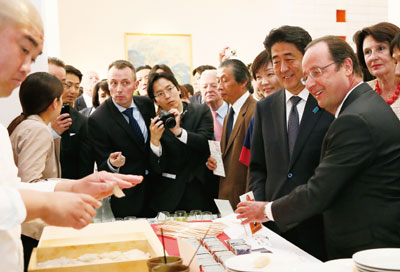 Prime Minister Abe at the reception to promote Japanese cuisine on his visit to France (May 5; Source: Cabinet Public Relations Office)
Prime Minister Abe at the reception to promote Japanese cuisine on his visit to France (May 5; Source: Cabinet Public Relations Office)
―Private and Public Sector Cooperation with the Aim of Winning the Order for Qatar Communications Satellite “Es’hail 2” ―
 Image of the “Es’hail 2” on its satellite orbit
Image of the “Es’hail 2” on its satellite orbit
Doha, the capital city of Qatar in the Middle East, the modern Hamad International Airport, which opened in May 2014 with a vast site and spacious passenger terminals, and the cityscape filled with skyscrapers in avant-garde designs at the heart of Doha, are all signs that convey the prosperity of this country. Qatar has drawn up plans for the ownership and operation of its own national communications satellite, the first of which is “Es’hail 2.” In 2014, Mitsubishi Electric partook in an international competitive bidding and emerged as the winner of the order for this satellite. This satellite, which will be Qatar’s first fully-owned communications satellite, is scheduled to be launched at the end of 2016. It will serve functions such as relaying Al Jazeera TV broadcasts, and will become an important communications infrastructure for Qatar.
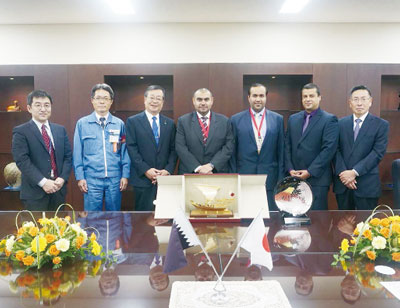 Commemorative photo for the success of the “Es’hail 2” (the author of this article is on the extreme left)
Commemorative photo for the success of the “Es’hail 2” (the author of this article is on the extreme left)
This project does not cover only building the satellite, but also includes the groundstations. In addition, the order contract also includes the training of key personnel who will be responsible for the operation and management of the satellite. The ordering party, state-owned satellite operator Es’hailSat (Qatar Satellite Company), which we had visited during our bid for the order, still comprises a small number of elite core members who are managing everything in the new but conspicuously empty offices. However, the company exudes a strong sense of dynamism and energy as a start-up that is likely to expand rapidly and fill up with talents from Qatar and abroad in the near future. To date, Qatar has maintained a strong relationship with Europe and the United States in the area of satellite communications business, and not had any such relationship with Japan, and this was the first time that we had visited Qatar. However, we could sense its strong ties with Japan and the sense of affinity that the people of Qatar had with Japan, demonstrated through examples such as the large number of Japanese cars driving through the streets of Doha, as well as the immense contribution that the federation of Japanese companies has made to the development of natural gas, which had brought Qatar a sudden bounty of wealth at the beginning of this century. Furthermore, we received support from the Government of Japan, provided through the Embassy of Japan in Qatar, in our efforts to approach the Qatar customers and promote our services. For example, we received assistance in providing explanations to the Government of Qatar about the high quality of our products. Such united efforts between the private and public sectors, brought about by cooperation with the Embassy, were a key factor that helped Mitsubishi Electric, a Japanese corporation, win the order for the communications satellite “Es’hail 2” against its European and American competitors. We will, of course, produce the communications satellite “Es’hail 2” with a quality that meets the expectations of our customers. At the same time, we hope that this project will serve as a catalyst for greater industrial exchange between Japan and Qatar in a wide variety of sectors.
Toshihiko Hayashi,
General Manager, Civil and Commercial Space Department, Mitsubishi Electric Corporation

